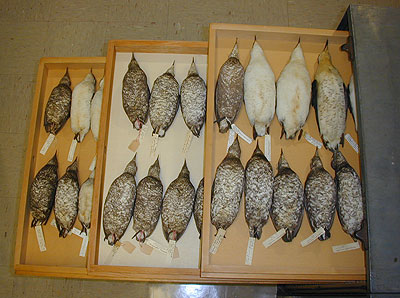Berkeleyan
 |
Researchers used marbled-murrelet specimens at the Museum of Vertebrate Zoology to estimate the threatened bird's historic population size. (Steven Beissinger photo) |
Explaining an endangered species' decline
Birth rates for the marbled murrelet - the focus of much conservationist concern - were higher a century ago than they are today, Berkeley researchers find in examining museum specimens
![]()
| 08 February 2007
To better understand why an endangered seabird's numbers plummeted over the past century, Berkeley researchers turned to museums for help. By studying marbled-murrelet specimens collected around the early 1900s, biologists have reconstructed the seabird's rates of reproduction and survival before its dramatic decline, providing for the first time a baseline measure of health to which contemporary populations can be compared.
| Murrelet habitat faces threats from industry and government alike |
This unique approach to studying the demography of an endangered species points to museum collections as an underutilized resource for diagnosing the causes of decline and measuring population changes in a species, the researchers say.
"Conservation biologists don't often have exact measures of what reproduction and survival rates should be for a healthy population," says Steven Beissinger, a Berkeley professor of environmental science, policy, and management. "Until about 30 years ago, systematic studies of the birth rates and death rates of wildlife species were rare."
That changed with the 1973 passage of the Endangered Species Act, which required biologists to assess a species' risk of extinction. When a population is unable to produce enough offspring to replace those that die, biologists know that it is in decline.
"The problem is that nobody has that sort of baseline data from 100 years ago," says M. Zachariah Peery, a former Ph.D. student in ecosystem sciences at Berkeley who is now a postdoctoral researcher at Moss Landing Marine Laboratory. "Usually what happens with endangered species is that biologists start to really study a species only after they realize it's in trouble. Museum specimens allow us to estimate the baseline level of success for a species. To the best of my knowledge, that has never been done before."
Little was known about the nesting habits of the marbled murrelet (Brachyramphus marmoratus) until 1974, when its first nest was discovered. Researchers now know that the seabird nests high in the canopy of coastal old-growth forests from California north to Alaska. Conservationists point to the murrelet's dwindling nesting habitat as a major factor in the seabird's decline. In 1992, the marbled murrelet was listed as endangered.
To get an idea of a population's historic size, biologists typically extrapolate from reports by early naturalists or biologists. Such reports can provide a general sense of the changes in a species' range but not changes in its birth or death rates - information that would be important to the development of benchmarks for the recovery of threatened or endangered species.
The researchers estimated rates of murrelet reproduction and survival by comparing the ratios of birds in different age groups using 170 specimens collected between 1892 and 1922 housed in the collections of the California Academy of Sciences and the campus Museum of Vertebrate Zoology. They compared these results with values predicted from comparison with other bird species and with contemporary rates obtained from murrelets they captured at sea and from their mark-recapture studies.
Using these methods, the researchers estimated that 100 years ago there were nearly 30 juvenile marbled murrelets for every 100 adults in the central California population they studied between Half Moon Bay and Santa Cruz, a ratio nearly identical to that predicted from comparative analysis. Today there are only three to four juveniles for every 100 adults.
At the historic rate of reproduction, a marbled murrelet population would have experienced a stable-to-healthy growth rate of 2 percent per year. (Murrelets lay only one egg each year, so the population, even when healthy, likely never grew very quickly.) The modern-day reproduction rate suggests a population declining at a rate of 7 to 9 percent per year, the researchers report.
"A change in reproduction levels for the marbled murrelet suggests limitations in nesting habitat and food availability, and increased predation on eggs and chicks by jays and ravens," says Peery. "Had survival rates been affected, it could have meant that more murrelets were being killed by peregrine falcons - which tend to prey on adults - or from oil spills."
A need for maximum protection
Says Berkeley's Beissinger: "Our results suggest the marbled murrelet will need all the protection it can get - both on land and at sea - to recover healthy rates of reproduction. Unfortunately, the U.S. Fish and Wildlife Service recently proposed to greatly reduce the area of old-growth forest designated for protection as critical habitat for this bird [see sidebar, below] and has not protected near-shore habitats at sea, where the murrelet spends most of its life."
There are limitations to using museum specimens to accurately represent the historic demography of a species. For example, specimens that happened to be easier to catch, such as the very young or old, may be represented disproportionately; further, not all collections are large enough to ensure adequate representation of the population at the time they were built.
These limitations were not a factor for the marbled murrelets in this study, however. Researchers found correspondence from collectors in the early 20th century indicating that collecting was fairly indiscriminate, involving men rowing out to sea with a shotgun to gather as many birds as possible. In addition, the researchers did not find juvenile marbled murrelets to be easier to capture than adults.
A significant number of other species may make good candidates for analysis through museum samples, says Beissinger. "Many museum collections across a broad array of taxas may prove to be useful. They are a neglected set of resources for conservation biologists, but we're starting to find more exciting and creative uses for them."
The researchers' study is described in the February issue of the journal Ecology.

